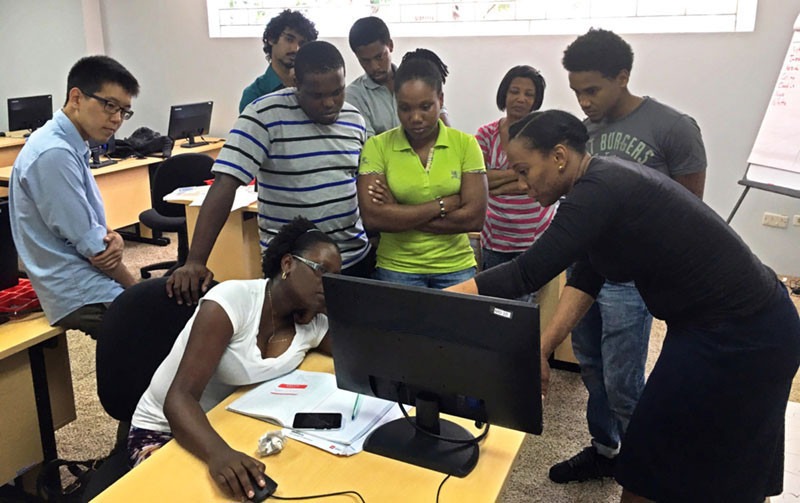[vc_row][vc_column][vc_column_text]
Caribbean teachers reboot school year with robotics
By Evelyn Rupert
[/vc_column_text][/vc_column][/vc_row][vc_row][vc_column width=”2/3″][vc_column_text]
Teachers in St. Lucia take a summer lesson of their own to learn about coding and robotics
A group of St. Lucia secondary school teachers stand in a circle, watching small Lego robots battle it out inside of a black ring drawn thick on white paper. Laughter and cheers erupt when one of the robots bowls its opponent over, wheels still spinning.
The Lego bots battle let teachers unleash the skills they learned through a summer training on coding and robotics – lessons they will in turn take back to their students once the school year starts in the fall.
Seven St. Lucian educators and two college student volunteers participated in an intensive training on coding and how to teach it through the Community, Family and Youth Resilience program, which is funded by the U.S. Agency for International Development and implemented by Creative Associates International and its partners.
“The coding and robotics course is very hands-on,” says math and science teacher Claudius Athil, who participated in the eight-day training. “At the core of the course is problem solving, and it challenges us as teachers and trainers to focus on logical thinking, following instructions, and forces one to be innovative.”
Empowering students with new tech skills
The program will provide four secondary schools in St. Lucia with computers and Lego Mindstorms kits, which allow students to build, customize and program their own robots. Teachers and volunteers will use the equipment and their training to incorporate coding into classes like math, physics and computer science. Schools will also launch after-school programs.
Up to 240 students will learn how to use a simple program to “write” code that can control a Lego robot’s movements.
For the robo-wrestling exercise, for example, teachers programmed their robots to rush full speed forward when they sensed another robot in front of them, move their arms up and down, and suddenly stop and go in reverse if their downward-facing color sensors registered that they were about to cross the black ring out of bounds.
The project, part of Creative’s Citizen Security Practice Area, is working in coordination with St. Lucia’s Ministry of Education, Innovation, Gender Relations and Sustainable Development to bring coding into more classrooms.
Germain Anthony, Curriculum Specialist for Technology Integration at the ministry, says coding will help students succeed in an increasingly tech-driven workforce.
“Students will only be fit for the workplace if they have skills that they can apply in the emerging digital world,” he says. “Coding is one of the most critical skills that will ensure that students can participate as producers and creators in the 21st century economy.”
Computer science teacher Simmons Jules says the coding will not only allow the students to gain technical knowhow, but life skills that they can apply elsewhere.
“Generally, coding is a skill which increases the thinking process and helps with cognition,” Jules says. “A course of this nature will help students at the lower spectrum, especially in areas of critical thinking and problem solving.”

A formula for crime prevention
USAID’s four-year Community, Family and Youth Resilience program focuses on the three Caribbean nations of St. Lucia, St. Kitts and Nevis and Guyana and is aimed at preventing crime and violence with a focus on at-risk youth.
The program will assess youth at risk for becoming engaged in crime and violence through the Youth Service Eligibility Tool (YSET), which measures risk across nine factors at a family, peer and individual level. Youth who are determined to be at high risk will be matched with counselors who work closely with families to improve behaviors and reduce risk factors.
The program also has a workforce component and will provide youth with opportunities for trainings and technical education while also developing soft skills as part of providing positive alternatives to youth development.
Chief of Party Debra Wahlberg says teaching youth to code will open doors to future opportunities that may not have been otherwise available to them – and help them contribute positively to their communities.
“Using problem solving and teamwork to accomplish a project objective – like building a robot – instills skills like patience, thinking through a process, and resolving conflict, all of which are critical in providing young people with skills that will serve them well throughout their lives, both in their work and in their interpersonal relationships with family and friends,” she says. “All of this is part of providing youth with protective factors and alternatives away from violence.”
Teachers gear up for the school year
At the end of their training, every teacher and volunteer had ideas for lessons they had tested on the group and plans to bring coding to their schools. Some intend to incorporate coding into their regular classes – like a physics teacher whose students could experiment with momentum using robots – while others will start after-school programs.
Anthony says the Ministry of Education is building up a support system to help teachers implement the curriculum, which will provide an exciting and valuable opportunity for students.
“This project is one of the initiatives that is helping to establish best practices in the system with respect to the use of new pedagogies,” he says. “We expect that both the mode of learning and the activities themselves will equip students with relevant knowledge, skills and attitudes.”
Each person who participated in the training also said that they are interested in helping train other teachers in the future, giving the curriculum the potential to expand widely across St. Lucia.
“The training opens doors to limitless possibilities with robotics,” says Jules.
With reporting by Jason Wilks and Eleanor Joseph from St. Lucia[/vc_column_text][/vc_column][vc_column width=”1/12″][/vc_column][vc_column width=”1/4″][vc_widget_sidebar sidebar_id=”sidebar-primary”][list_category_posts_widget title=”Related Stories:” cat_id=”243,255″ order_by=”date” numberposts=”3″ excerpt=”yes” excerpt_size=”15″][/vc_column][/vc_row]